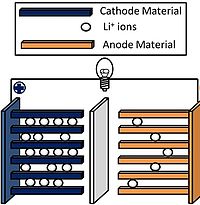
Photo from wikipedia
Abstract Li[Ni1/3Co1/3Mn1/3]O2 cathode active materials are synthesized from co-precipitated hydroxide precursors Lix[Ni1/3Co1/3Mn1/3]1-x(OH)2, and the effect of residual Li in the precursors on the lithium-ion battery (LIB) performance of their corresponding… Click to show full abstract
Abstract Li[Ni1/3Co1/3Mn1/3]O2 cathode active materials are synthesized from co-precipitated hydroxide precursors Lix[Ni1/3Co1/3Mn1/3]1-x(OH)2, and the effect of residual Li in the precursors on the lithium-ion battery (LIB) performance of their corresponding cathode active materials is investigated. Three kinds of precursors that contain different amounts of Li are selected depending on different conditions of the solution composition for the co-precipitation and washing process. It is confirmed that the introduction of Li to the precursors reduces the degree of structural perfection by X-ray diffraction analysis. Undesirable cation mixing occurs with the increasing Li content of the precursors, which is inferred from a decline in lattice parameters and the calculated intensity ratio of (003) and (104) peaks. In the voltage range of 3.0–4.3 V, the initial charge/discharge capacities and the rate capability of the cathode active materials are aggravated when Li exists in the precursors. Therefore, it could be concluded that the strict control of Li in a solution for co-precipitation of precursors is necessary in the resynthesis of cathode active materials from spent LIBs.
Journal Title: Journal of Physics and Chemistry of Solids
Year Published: 2018
Link to full text (if available)
Share on Social Media: Sign Up to like & get
recommendations!